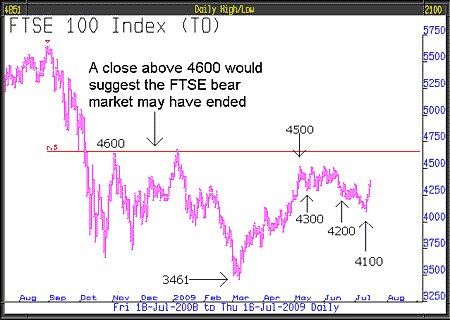
In our previous issue of threesixty we said “We believe that the stock market rally, that started 9th March, has now ended and, so far, what has followed is a deteriorating stalemate, prices heading sideways/downwards”.
It might seem from the FTSE chart that the price has recovered from its most recent low. So is our technical signal following the break below 4,300 and subsequently 4,200 obviated as a result of this rally? The answer is no. The consolidation between 4,300 and 4,500 ended on 11th June when the intra-day price fell to 4,255. That was the determining factor.
Because the consolidation period had ended, our opinion is that the new downward direction of the stock market is determined. Any rally back to 4,300 or even 4,500 does not reverse that signal unless, the price closes above 4,500; in which case, we would deem our signal to have failed and the future direction of the market to be uncertain.
If there is to be a perfect technical outcome then the price for FTSE will, from about here, again reverse. If that takes the price below 4,100 the bear market will have delivered its next very strong signal about where it is going – south!
In the Wall Street Journal on Thursday 16th July, Andy Kessler, hedge fund manager and author of “How we got here”, wrote about “The Bernanke Market”. He dramatically illustrated that the US stock market this year has matched WSBASE (sum of currency in circulation). The effect of the blizzard of money creation and zero interest rates has been reflected in the performance of the stock market, meaning that the Fed’s monetary policy has not got banks lending to households and companies, and stabilised the housing market without which the US economy won’t grow. Instead, it has fuelled a bear market rally in equities.
The UK and US economies are made up of 70% consumer spending; so unless consumers are willing to abandon their new practice of saving and paying down debt rather than spending, where can the economy go but down? Consumers are the plankton of the financial food chain – if the plankton in the sea dies, the big fish that feed off smaller fish, that feed off the littler fish, that feed off the plankton, will all perish.
In the Daily Telegraph Business section, 16th July, under the headline “Idle factories risk deflation spiral says World Bank”. Ambrose Evans-Pritchard said that the World Bank warns that the global economy could fall into a deflationary spiral risking further spasms of financial distress.
Of all the puzzles to be solved, inflation or deflation is the biggy. We have for a long time said, even when central banks and pundits were warning of inflation, even hyperinflation, that the big danger is deflation. As obvious as the inevitable inflationary outcome seems, prices are still falling not rising, unemployment is rising not falling, wages are declining not rising and global excess capacity is rife. Printing money is the only thing that’s keeping us out of deflation. Imagine how deflationary the stock market, property market, jobs, the whole caboodle would be if money had not been printed and injected into the system.
We would recommend the article by Martin Wolf published in the FT on Wednesday 15th July, headlined “After the storm comes a hard climb“. As always his words are insightful and he ticks virtually all the boxes. To quote from that article:
“Private sector prudence is likely to endure in a post-bubble world characterised by mountains of debt. In the last quarter of 2008 and the first quarter of 2009, US household borrowing was modestly negative. But at the end of the first quarter of 2009 the ratio of gross household debt to GDP was a mere 2% of GDP lower than at the end of 2007. De-leveraging is a painful process: it has barely begun.
“If, as is likely, the private sector remains prudent, the public sector will remain profligate. Moreover, so long as this period of retrenchment lasts, the risk will not be inflation but rather deflation. The lesson which is apparent is that fiscal profligacy and deflationary pressure can last longer than anybody imagines.”
Economists Van R Hoisington and Dr Lacy Hunt, on the same subject from their quarterly review and outlook, second quarter 2009, headlined “Debt and deflation” concluded that:
“The combination of an extremely overleveraged economy, ineffectual monetary policy and misdirected fiscal policy initiatives suggests that the US economy faces a long difficult struggle. While depleted inventories and the buildup of pent-up demand may produce intermittent spurts of growth, these brief episodes are not likely to be sustained. In several years, real GDP may be no higher than its current levels. However, since the population will continue to grow, per capita GDP will decline; thus, the standard of living will diminish as unemployment rises. These conditions will produce a deflationary environment similar to the Japanese condition.”
It is a well-known truth that in matters economic and financial “the majority are invariably wrong”. From October 2007 to September 2008 only one member of the Bank of England’s Monetary Policy Committee, Danny Blanchflower, repeatedly voted for lower interest rates. It was presumed, because he was in the minority that he was wrong and that the majority must be right. Instead, he was correct and the majority were unequivocally wrong – the MPC dramatically capitulated in October 2008. We suspect President Obama is faced with a similar problem, amongst his gang of advisors the only one giving the right advice is ignored because he is in the minority.
• This article was written by Full Circle Asset Management, as published in the threesixty on 19 June 2009